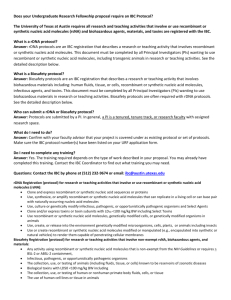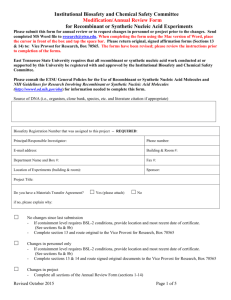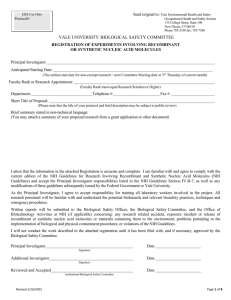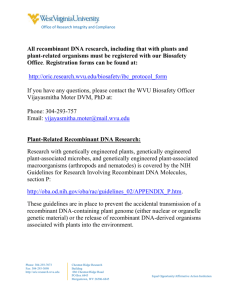BSL2, 3, 4 Agents, rDNA, and Select Agents form
advertisement
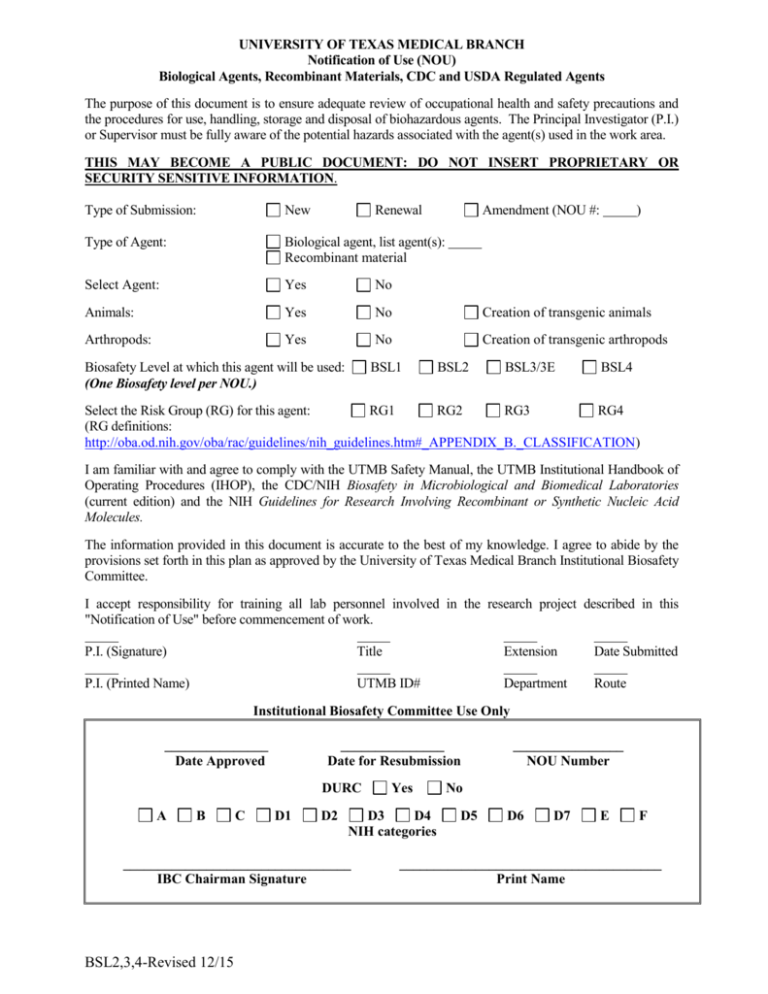
UNIVERSITY OF TEXAS MEDICAL BRANCH Notification of Use (NOU) Biological Agents, Recombinant Materials, CDC and USDA Regulated Agents The purpose of this document is to ensure adequate review of occupational health and safety precautions and the procedures for use, handling, storage and disposal of biohazardous agents. The Principal Investigator (P.I.) or Supervisor must be fully aware of the potential hazards associated with the agent(s) used in the work area. THIS MAY BECOME A PUBLIC DOCUMENT: DO NOT INSERT PROPRIETARY OR SECURITY SENSITIVE INFORMATION. Type of Submission: New Renewal Type of Agent: Biological agent, list agent(s): Recombinant material Select Agent: Yes No Animals: Yes No Creation of transgenic animals Arthropods: Yes No Creation of transgenic arthropods Biosafety Level at which this agent will be used: (One Biosafety level per NOU.) BSL1 Amendment (NOU #: BSL2 BSL3/3E ) BSL4 Select the Risk Group (RG) for this agent: RG1 RG2 RG3 RG4 (RG definitions: http://oba.od.nih.gov/oba/rac/guidelines/nih_guidelines.htm#_APPENDIX_B._CLASSIFICATION) I am familiar with and agree to comply with the UTMB Safety Manual, the UTMB Institutional Handbook of Operating Procedures (IHOP), the CDC/NIH Biosafety in Microbiological and Biomedical Laboratories (current edition) and the NIH Guidelines for Research Involving Recombinant or Synthetic Nucleic Acid Molecules. The information provided in this document is accurate to the best of my knowledge. I agree to abide by the provisions set forth in this plan as approved by the University of Texas Medical Branch Institutional Biosafety Committee. I accept responsibility for training all lab personnel involved in the research project described in this "Notification of Use" before commencement of work. P.I. (Signature) Title Extension Date Submitted P.I. (Printed Name) UTMB ID# Department Route Institutional Biosafety Committee Use Only _______________ Date Approved _______________ Date for Resubmission DURC A B C D1 D2 D3 D4 NIH categories _________________________________ IBC Chairman Signature BSL2,3,4-Revised 12/15 Yes ________________ NOU Number No D5 D6 D7 E F ______________________________________ Print Name SECTION I: General information NOU(s) expire every 5 years. Updates must be submitted annually [form sent by Environmental Health and Safety (EHS)]. Amendments to the NOU do not change the renewal date, the original approval dates apply. 1. List agent(s) (include strains or generation; no abbreviations): Attach a copy of the pathogen safety data sheet if available, (http://www.phac-aspc.gc.ca/lab-bio/res/psds-ftss/index-eng.php) or supporting safety information (e.g. manufacturer safety, data or fact sheet). 2. Goal of the project (1-2 sentences): 3. Description of use (include techniques used for in-vitro, in-vivo and vector work. Do not copy detailed protocols or grant information; this section should be ¼ to ½ page long): 4. Location: Building(s): Room(s): 5. Occupational Health a. Can this agent infect humans? No (proceed to question 6) Yes Unknown b. Is the infection associated with replication in humans or is it abortive (no infectious progeny, for example viral replicons or defective adenoviral vectors)? Abortive (proceed to question 6) Unknown Replicative i. Can the agent cause disease in healthy humans? No Yes Unknown If yes and no are both checked (e.g., multiple agents are listed in #1), provide an explanation: ii. Can the agent cause disease in immunocompromised humans? No Yes Unknown If yes and no are both checked (e.g., multiple agents are listed in #1), provide an explanation: c. Are all personnel enrolled in the Employee Occupational Health Program? No Yes d. Is medical surveillance recommended for the agent(s) prior to commencement of work? (Aside from the Respiratory Fit Program and/or BSL-4 physical.) No Yes BSL2,3,4-Revised 12/15 If yes, please explain e. Is a vaccine available for the agent? No (proceed to question 6) Yes, FDA approved Internationally available List vaccine: Experimental (IND) i. Is immunization required for work at the listed biosafety level? (Aside from Yellow Fever vaccine for BSL-3 users.) No Yes ii. Is immunization recommended at the listed biosafety level? No Yes 6. Agent Assessment (Answers are to be based on this scope of work in-vitro) a. Provide the following: i. Maximum volume to be cultured/handled at one time per container (e.g. flask, tubes, roller bottles): ii. Maximum number of containers cultured/handled at one time: iii. Maximum concentration to be cultured/handled at one time: iv. Are you going to concentrate your agent prior to experimental use? No Yes: Final total volume: Final concentration: Indicate the procedure that requires concentration of the agent: b. Describe agent stability in the environment i. Agent stability in regards to spill, fomites, survival outside of host: ii. Susceptibility to decontamination (heat, chemical inactivation): c. Describe potential routes of lab transmission. Inhalation Mucous membrane Animal bite Ingestion Sharps (including needle sticks) Other: d. What is the origin of the infectious material and from where will you specifically receive the agent? Existing stock Clinical isolate location: Field sample location: Commercially purchased Collaborator Other: e. Describe pathogenicity, including disease incidence and severity in humans. Not infectious (proceed to question 7) f. What is the infectious dose in humans? (If unknown, state whether or not the dose being used can be expected to cause infection.) i. If human data is not available, summarize from the most appropriate animal model studies (pathogenicity, infectivity and route of shedding from animals)? BSL2,3,4-Revised 12/15 7. Agent Inactivation a. Will the project involve inactivating agent or samples? No (proceed to question 8) Yes b. Reason for agent/sample inactivation To work at the same biosafety level To work at a lower biosafety level For shipment Other: c. Inactivation and Verification Procedure(s) Please provide a detailed SOP of the inactivation procedure(s) and validation procedure(s) for complete inactivation. This should also include the frequency of validation testing. 8. Personnel Notification a. Have personnel listed read this NOU? Yes No personnel present at this time, personnel will be trained as they are hired. b. Will personnel receive training (documented) on safe agent handling and decontamination procedures prior to commencing work? Yes No personnel present at this time, personnel will be trained as they are hired. 9. Evaluation of Dual Use potential experiments of concern (US Government Policy for Institutional Oversight of Life Sciences Dual Use Research of Concern). If answer is “yes”, please explain in detail. a. Is it likely that the harmful consequences of the agent will be enhanced? No Yes, explain in detail: b. Is it likely that the immunity or effectiveness of an immunization against the agent without clinical and/or agricultural justification will be disrupted? No Yes, explain in detail: c. Is it likely that: i. resistance to clinically and/or agriculturally useful prophylactic or therapeutic interventions will be conferred to the agent? No Yes, explain in detail: ii. the agent’s ability to evade detection methodologies will be facilitated? No Yes, explain in detail: d. Is it likely that the stability, transmissibility, or the ability to disseminate the agent will be increased? No Yes, explain in detail: e. Is it likely that the host range or tropism of the agent will be altered? No Yes, explain in detail: BSL2,3,4-Revised 12/15 f. Is it likely that the susceptibility of a host population to the agent will be enhanced? No Yes, explain in detail: g. Is it likely that an eradicated or extinct agent will be generated or reconstituted? No Yes, explain in detail: 10. Agent Propagation a. Will agent(s) be propagated on this study? No (proceed to question 11) Yes b. What systems (cells and bacteria) will be used to propagate the agent(s) listed? N/A (e.g. broth or agar) i. Cells of arthropod or animal origin: ii. Cells of human or nonhuman primate origin: Human or nonhuman primate product NOU approval number(s): iii. Bacteria: 11. Check the personal protective equipment (PPE) worn when handling agent(s) in-vitro: Lab coat/gloves/eye protection (BSL2) Cover gown/gloves/eye protection (BSL3) Scrubs/cover gown/ gloves (BSL3E) Positive pressure suits (BSL4) Face Shield Other specify: Surgical mask N95 respirator Full/half-face respirator PAPR 12. Check lab equipment used when handling agent(s) in-vitro: Centrifuge (Sealed lid and cups/bucket) Building/Room: Blender Homogenizer, type: Sonicator Shaker Building/Room: Chemical Fume Hood: Building/Room: Biological Safety Cabinet: Building/Room: Other specify: 13. Method for disposal of biohazardous waste: Placed in red bag for disposal. Autoclaved, then placed in regular trash. Chemically disinfected, then placed in regular trash. Placed in yellow bag for incineration. Chemical disinfection or autoclave of bulk liquid, then poured down sanitary drain or BSL3E/BSL4 effluent treatment system. Autoclaved, then packaged for incineration. Other: 14. List disinfectant(s) used for surface decontamination and spills: Cavicide MicroChem % Bleach % Other % 15. Complete the personnel experience table at the following link: Personnel Experience Table BSL2,3,4-Revised 12/15 Attached If you are planning recombinant or synthetic nucleic acid molecules work, please fill out Section II N/A If you are planning any animal work, please fill out Section III N/A If you are planning any arthropod vector work, please fill out Section IV N/A BSL2,3,4-Revised 12/15 SECTION II: Recombinant Material http://oba.od.nih.gov/oba/rac/guidelines/nih_guidelines.htm Definition of recombinant and synthetic nucleic acid molecules per NIH-OBA guidelines In the context of the NIH Guidelines, recombinant and synthetic nucleic acids are defined as: (i) molecules that are constructed by joining nucleic acid molecules that can replicate in a living cell, or (ii) nucleic acid molecules that are chemically or by other means synthesized or amplified, including those that are chemically or otherwise modified but can base pair with naturally occurring nucleic acid molecules, or (iii) molecules that result from the replication of those described in (i) or (ii) above. 1. Goal of the project involving recombinant work: 2. Description of recombinant work: 3. Location: Building(s): Room(s): 4. Will synthetic DNA other than primers be used, or will material be sent to be synthesized? No Yes , please explain: 5. Will rDNA be propagated on this study? No (material is received ready for use) Yes, please explain: 6. Clone manipulation a. Will there be clone modification performed in your lab? N/A, there will be no clone manipulation performed. Proceed to question 7. Yes, please explain: b. At what biosafety level will you be conducting the cloning portion (not rescue) of your research: BSL1 BSL2 BSL3 BSL4 c. Will full-length clones be created? No Yes, please explain: 7. Please complete the following table. List Vectors/Inserts Commercially Purchased Provided by Collaborator Cloned in lab space listed above If applicable; list company name and product number 8. Please complete the following table. Complete for all recombinant material regardless of whether the lab is doing the manipulation. Origin of Insert Name of Vector(s) Name of Host(s) Gene of Interest If an attempt will be DNA/RNA Used (plasmid or Used made to obtain virus/strain) (bacteria/strain, expression of a BSL2,3,4-Revised 12/15 virus/strain or cells) List each step of the cloning process foreign gene, indicate the specific protein that will be produced List each step of the cloning process, including final step (E. coli, etc.) 9. Answer the following questions. a. Does the inserted gene encode a known oncogene? b. Does the viral DNA integrate into the host genome? c. Does the inserted gene have the potential for altering the cell cycle? d. Is there a probability of generating replication-competent viruses? If yes to any of the above, please explain: Yes No Yes No Yes No Yes No Exempt Experiments. The following recombinant or synthetic nucleic acid molecules are exempt from the NIH Guidelines and registration with the Institutional Biosafety Committee (IBC) is not required. 10. Will the experiment include synthetic nucleic acids that: a. Can neither replicate nor generate nucleic acids that can replicate in any living cell? b. Are not designed to integrate into DNA? c. Do not produce a toxin that is lethal for vertebrates at an LD50 of less than 100 nanograms per kilogram body weight? BSL2,3,4-Revised 12/15 Yes No Yes No Yes No F-1 11. Will the experiment include recombinant or synthetic nucleic acids that are not in organisms, cells or viruses and that have not been modified or manipulated (e.g., encapsulated into synthetic or natural vehicles) to render them capable of penetrating cellular membranes? 12. Will the experiment include recombinant or synthetic nucleic acids that consist solely of the exact recombinant or synthetic nucleic acid sequences from a single source that exists contemporaneously in nature? 13. Will the experiment include recombinant or synthetic nucleic acids that that consist entirely of nucleic acids from a prokaryotic host, including its indigenous plasmids or viruses when propagated only in that host (or a closely related strain of the same species), or when transferred to another host by well-established physiological means? 14. Will the experiment include recombinant or synthetic nucleic acids that consist entirely of nucleic acids from a eukaryotic host including its chloroplasts mitochondria, or plasmids (but excluding viruses) when propagated only in that host (or a closely related strain of the same species)? Contact EHS before starting. 15. Will the experiment include recombinant or synthetic nucleic acids that consist entirely of DNA segments from different species that exchange DNA by known physiological processes, though one or more of the segments may be a synthetic equivalent? See Section IV-C-1-b-(1)-(c), Major Actions), as determined by the NIH Director, with the advice of the RAC, and following appropriate notice and opportunity for public comment. See Appendices A-I through A-VI, Exemptions under Section III-F-6 for a list of natural exchangers that are exempt from the NIH Guidelines. 16. Will this experiment include genomic DNA molecules that have acquired a transposable element, provided the transposable element does not contain any recombinant and/or synthetic DNA? 17. Will the experiment include recombinant or synthetic nucleic acids that do not present a significant risk to health or the environment? See Section IV-C-1-b-(1)-(c), Major Actions, as determined by the NIH Director, with the advice of the RAC, and following appropriate notice and opportunity for public comment. See Appendix C, Exemptions under Section-III-F-8 for other classes of experiments which are exempt from the NIH Guidelines. 18. Will this work involve the deliberate transfer of a drug resistance trait to microorganisms that are not known to acquire the trait naturally (other than Escherichia coli cloning selection)? Could this acquisition compromise the use of the drug to control disease agents in humans, veterinary medicine, or agriculture? 19. Will this experiment involve the cloning of toxin molecules with LD50 of less than 100 Nanograms per Kilogram body weight (e.g., microbial toxins such as the botulinum toxins, tetanus toxin, diphtheria toxin, and Shigella dysenteriae neurotoxin)? If no, please go to section C-1. a. Provide LD50 ng/kg of body weight: b. Is this molecule lethal to vertebrates at 100 ng to 100 mg per kg body BSL2,3,4-Revised 12/15 Yes No F-2 Yes No F-3 Yes No F-4 Yes No F-5 Yes No F-6 Yes No F-7 Yes No F-8 Yes No A-1a Yes No Yes No Yes B-1 weight? c. Is the cloning done in Escherichia coli K-12? 20. Will this experiment involve the deliberate transfer of recombinant or synthetic nucleic acid molecules, or DNA/RNA derived from recombinant or synthetic nucleic acid molecules, into one or more human research participants. Contact EHS before submitting. 21. Will this experiment involve using Risk Group 2, Risk Group 3, Risk Group 4, or Restricted Agents as Host-Vector Systems? 22. Will this experiment involve DNA from Risk Group 2, Risk Group 3, Risk Group 4, or Restricted Agents to be Cloned into Nonpathogenic Prokaryotic or Lower Eukaryotic Host-Vector Systems? If no, please go to section D-3 23. If the DNA is from a Risk Group 4 agent, does the recombinant contain a totally and irreversibly defective fraction of the agent's genome? [If No: work must be done at BSL4] 24. Will this experiment involve the Use of Infectious DNA/RNA Viruses in Tissue Culture Systems? 25. Will this experiment involve the Use of Defective DNA/RNA Viruses in the presence of Helper Virus in Tissue Culture Systems? 26. Will this experiment involve viable recombinant or synthetic nucleic acid molecule-modified microorganisms to be tested on whole animals? 27. Will this experiment involve the use of whole animals in which the animal's genome has been altered by stable introduction of recombinant or synthetic nucleic acid molecules, or nucleic acids derived therefrom, into the germ-line (creating transgenic animals)? No Yes No Yes No C-1 Yes No D-1 Yes No D-2 Yes No N/A Yes No Yes No D-3 Yes No D-4 Yes No 28. Will this experiment involve the use of whole Plants? Contact EHS before submitting. Yes No D-5 / E-2 29. Will this experiment involve more than 10 Liters of culture? Contact EHS before submitting. Yes No D-6 30. Will this experiment involve work with influenza virus? Experiments with influenza viruses generated by recombinant or synthetic methods (e.g., generation by reverse genetics of chimeric viruses with re-assorted segments, introduction of specific mutations) shall be conducted at the biosafety level corresponding to the risk group of the virus that was the source of the majority of segments in the recombinant or synthetic virus. BSL2,3,4-Revised 12/15 Yes No (proceed to question 32) D-7 31. Will experiments involve work with the following influenza viruses? b. Human H2N2 (1957-1968)-virus containing H2 hemagglutinin (HA) gene in cold-adapted, live attenuated vaccine strains (e.g., A/Ann Arbor/6/60 H2N2) in which the segments with mutations conferring temperature sensitivity and attenuation are not altered in the recombinant virus. c. Human H2N2 (1957-1968)-virus containing genes from human H2N2 other than the HA gene. d. Highly Pathogenic Avian Influenza H5N1 strains (within the Goose/Guangdong/96-like H5 lineage (HPAI H5N1) containing a minority of genes and/or segments from a HPAI H5N1 influenza virus. e. Highly Pathogenic Avian Influenza H5N1 strains (within the Goose/Guangdong/96-like H5 lineage (HPAI H5N1) containing a majority of genes and/or segments from a HPAI H5N1 influenza virus. Yes No D-7a Yes No Yes No D-7b Yes No Yes No D-7c Yes No D-7d (if yes, mark A-1 yes also) 32. Will this experiment involve the Formation of Recombinant or Synthetic Nucleic Acid Molecules Containing No More than TwoThirds of the Genome of any Eukaryotic Virus? Yes No E-1 33. Will this experiment involve the use of arthropods or small animals with recombinant or synthetic nucleic acid molecule-modified microorganisms? Yes No f. Influenza viruses containing any gene or segment from 1918 H1N1. g. Will the experiment involve work with an influenza virus containing genes from one of 1918 H1N1, HPAI H5N1, and human H2N2 (1957-1968) viruses that is resistant to both classes of current antiviral agents, adamantanes and neuraminidase inhibitors? If yes, contact EHS before submission 34. Will this experiment involve the use of recombinant DNA-modified arthropods or small animals associated with plants? 35. Will this experiment involve the generation of transgenic rodents? This section covers experiments involving the generation of rodents in which the animal's genome has been altered by stable introduction of recombinant or synthetic nucleic acid molecules, or nucleic acids derived therefrom, into the germ-line (transgenic rodents). Only experiments that require BSL1 containment are covered under this section. E-2-b-5 Yes No Yes No E-3 If you are planning any animal work, please fill out Section III N/A If you are planning any arthropod vector work, please fill out Section IV N/A BSL2,3,4-Revised 12/15 Section III: Animal Use IACUC Protocol #: IACUC Approval date: Species: PI name if different from NOU PI: 1. Provide a project description specific to animal study; include procedures, treatments, challenge materials and sampling per species: 2. Will the infected animal present a human health risk after administration? No Yes, provide the following information: Route of exposure: Respiratory Saliva Milk Blood Urine Other: Feces 3. What animal facility is recommended? ABSL2 for inoculation then housed in ABSL1 after a 72 hr. hold ABSL2 ABSL3 ABSL3E ABSL4 4. Check the PPE that will be worn (eye protection is to be used at all biosafety levels): Standard PPE for the animal facility Full/ half-face respirator PAPR N95 respirator Surgical mask Other (specify): 5. Check lab equipment that will be used: Biological safety cabinet Chemical fume hood Downdraft table Other (specify): 6. Dose per animal: a. Maximum volume to be administered at one time: b. Maximum concentration to be administered at one time: 7. Route of administration: Intracranial Intravenous Aerosol Bronchial Intraperitoneal Subcutaneous Gavage Intrathecal Intradermal Intracardiac Topical Other: Intramuscular Intranasal Oral 8. Sampling: Retro-orbital bleeds Intravenous bleeds Throat swabs Feces Submandibular bleeds Saphenous bleeds Urine Organs 9. Will tissue homogenization be performed? No Yes (provide a written protocol) BSL2,3,4-Revised 12/15 Intracardiac bleeds Nasal swabs Bronchoalveolar lavage Other: 10. Please describe how body fluids from perfusions will be collected and treated for disposal. N/A, no perfusions are performed 11. Will the study use: a. Recombinant material Yes No b. Viral vectors Yes No i. Are the vectors replication deficient? Yes No ii. Are there safety concern(s) associated with the vectors used; if so, please explain (please indicate if the vector is expected to shed within 72 hours). iii. Are there any toxins, virulence factors or oncogenes associated with the expression of the transgene; if so, please explain. c. Gene transfer experiments Yes No d. Creation of transgenic animals Yes No 12. Will animals be transported out of or between the vivarium(s)? No (proceed to question 13) Yes, please describe below: a. Reason for removal: b. Location of animal manipulation/necropsy: c. Procedures for transportation of cages to and from vivarium: d. PPE worn by all personnel present in the lab: e. PPE worn by those handling animals: 13. Are there any deviations from standard facility procedures? No Yes , please describe below If you are planning any arthropod vector work, please fill out Section IV. BSL2,3,4-Revised 12/15 N/A Section IV: Arthropod Use 1. Provide a description of the project, specific to arthropod study: 2. Arthropod to be used: Species: Mosquitoes 3. Indicate life stage used: Eggs Ticks Fleas Larvae Lice Nymphs Other: Adults 4. Where will the arthropod work be conducted? Building: Room Location: 5. Check the PPE that will be worn (eye protection is to be used at all biosafety levels): Standard PPE for the arthropod facility Full/ half-face respirator PAPR N95 respirator Surgical mask Other (specify): 6. Check lab equipment that will be used: Biological safety cabinet Chemical fume hood Glovebox Other (specify): 7. Infection method for arthropod: Intrathoracic inoculation Intrarectal inoculation Animal feeding (specify host): Intracoelomic inoculation Submersion Artificial blood meal Other (specify): 8. Will arthropod homogenization be performed? No Yes (provide a written protocol) 9. Will the study use: a. Recombinant material Yes No b. Viral vectors Yes No i. Are the vectors replication deficient? Yes No ii. Are there safety concern(s) associated with the vectors used; if so, please explain. iii. Are there any toxins or virulence factors associated with the expression of the transgene; if so, please explain. c. Gene transfer experiments Yes No d. Creation of transgenic arthropods Yes No 10. Will arthropods be transported out of or between the insectary? No (proceed to question 11) Yes, please describe below: BSL2,3,4-Revised 12/15 a. Reason for removal: b. Location of arthropod manipulation/necropsy: c. Procedures for transportation and containment of arthropods: 11. Are there any deviations from standard facility containment procedures? No Yes , please describe below BSL2,3,4-Revised 12/15
